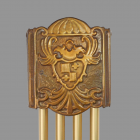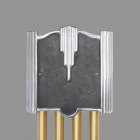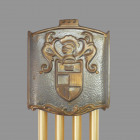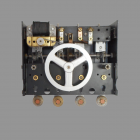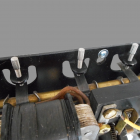Cam-Driven Westminster Door Chime 1936

Cam Driven Westminster Door Chime ~1936
This chime features the same unique cam-driven strike scheme patented by Edwin G. Anderson of San Diego, California in 1934. This chime is presumed to be a derivative of the earlier chime since many features and components are identical including the Barber-Colman C-Frame motor, round weights and raw-hide striker tips.
The most significant difference is in the design of the striker arms. In the earlier chime, leaf spring assemblies were forced backwards by the rotation of cam fingers and then suddenly released to strike the chime tubes. In this later chime, the rotating cam depresses a shorter piece of spring steel arranged perpendicular to the striker arms. This enables a more precise adjustment by means of screws near the top of the mechanism. Additionally, the raw-hide strikers are kept from resting on the bells by adjustable felt dampers. These dual adjustments enable each note to be precisely tuned for sustain and volume.
These refinements were apparently anticipated by Mr. Anderson as his original patent application references “appended claims” so as not to limit his invention to any “particular construction”. Thus, I believe this example dates to sometime between the date of his application in May of 1934 and the grant of patent 2,104,963 in January of 1938.
Other refinements include a larger diameter pulley to furnish greater torque for the mechanism. The micro-switch that controls the cycle is now activated by an arm extending from a brass gear on the camshaft in place of a separate cam wheel on the earlier chime. And each cam finger is individually adjustable so they may be clustered in a tighter rotation if a faster eight note melody is desired. Similarly, cam fingers may be removed if a four-note sequence is desired. Indeed, the cams can be arranged so as to play an entirely different tune if desired.
These Cam-driven musical chimes have few advantages over the much more common solenoid driven chimes while burdened with several disadvantages. Cam-driven chimes are limited to a single call with no facility for a second or third door. Nor can they be employed as electrically operated remote servant calls for individual rooms. Still, these fascinating chimes achieved at least some success in the marketplace as I have encountered several.
Covers for this mechanism are made of stamped brass and finished in copper, chrome or aged brass as shown in the gallery below.
Please contact the doorbell museum with any information you may have on these cam-driven chimes.
| Manufacturer | Unknown. Believed to be later model patented by Edwin G. Anderson |
| Location of Manufacture | Unknown. Presumed to be California |
| Date of Manufacture | ~1936 |
| Cover | Coat of Arms: Copper plated brass. Deco: Chrome plated stamped brass with simulated alligator skin. Knight: Stamped brass. |
| Mechanism | Plate Steel with brass gears and spring steel striker mechanisms. |
| Bells | Brushed Brass |
| Height | 56 inches |
| Width | 9 1/2 inches |
| Depth | 3 3/4 inches |
| Notes | Restored mechanism. Replacement Brass bells. |
